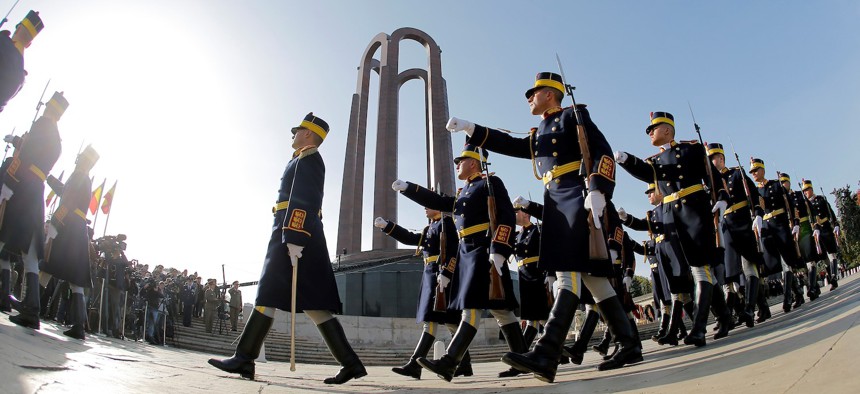
Soldiers march during celebrations marking the Army Day in Bucharest, capital of Romania, Oct. 25, 2022. Xinhua via Getty Images / Cristian Cristel
Defense Industry Should Build in NATO’s Eastern Flank, Romanian Land Forces Chief Says
As the U.S. and NATO footprint on Ukraine and Russia’s border grows, so do their industrial base needs.
BRASOV, Romania–As NATO and the Western allies grapple with how to provide long-term support to Ukraine, the head of Romania’s land forces says the Western military industrial base should start by moving more operations to NATO’s eastern flank. That will be especially important to support the further integration of NATO elements in the region and deepen the partnership between the U.S. and partner militaries near the front lines of the war, he said.
Since the beginning of Russia’s expanded invasion of Ukraine, the United States has positioned a larger number of forces in Romania, moving 1,000 troops eastward from Germany in February and a brigade combat team from the 101st Airborne Division in July. “That means for me, from Romanian land forces, a variety of opportunities and challenges to train together. But the paradigm changes. So it's not just training to provide interoperability, it's training for the mission. We're closer to the consequences of the war in Ukraine,” Maj. Gen. Iulian Berdilă, the chief of staff for Romanian land forces, told Defense One on Thursday during a defense resources management conference here.
And the growth of U.S. force presence across the wider region also supports more industrial base activity moving eastward, Berdilă said.
“Now you have the V Corps” he said, referring to the Army V Corps that will be based in Poland. “You have other headquarters from the allies and partners joining the training and interoperability platform. You have such a volume, especially land. You need an apparatus and a capacity in the industrial volume to be synchronized. …Where is the capital investment in the know-how of the allies on the Eastern Front? … This is an opportunity for industry to go adapt, to be agile in a global perspective, but also to capitalize on an opportunity for business development, to capacitate allies and to produce equipment and logistics.”
While NATO allies are treaty-bound to defend NATO land territory, the Black Sea—controlled by Russia, Georgia, Turkey, Bulgaria and Romania—has seen some of the most intense fighting in the Ukraine-Russia war so far, as well as increases in illegal Russian smuggling. And as militaries increasingly focus on integrating air, land, sea, space, and cyberspace operations, Berdilă believes that strengthening Romanian land forces is essential to securing the Black Sea.
“How do you exercise that multi-domain? You take land capabilities and provide effects into maritime and vice versa. You can have sensors from the Air Force to be used with the land to produce the effects on the battlefield. And this why… in this area of the southeastern part of the Black Sea region … I think the land remains decisive.”
The war in Ukraine has highlighted the importance of high maneuverability to accelerate the observe, orient, decide and act cycle, he said, as well as the growing role of urban centers in future conflicts. But the war is changing too quickly to make credible predictions about what will happen next.
“We have to go step by step. We have to see … what the winter will bring, pre-winter and post-winter. And then we have to calibrate to see what are the developments towards 2023. So I think because of the speed of the conflict and the character of the conflict, we need to be very careful of how we measure our way forward.”





